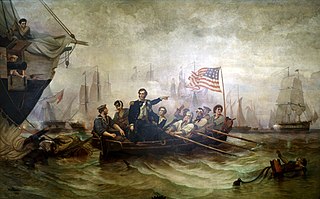
The Battle of Lake Erie, also known as the Battle of Put-in-Bay, was fought on 10 September 1813, on Lake Erie off the shore of Ohio during the War of 1812. Nine vessels of the United States Navy defeated and captured six vessels of the British Royal Navy. This ensured American control of the lake for the rest of the war, which in turn allowed the Americans to recover Detroit and win the Battle of the Thames to break the Indian confederation of Tecumseh. It was one of the largest naval battles of the War of 1812.
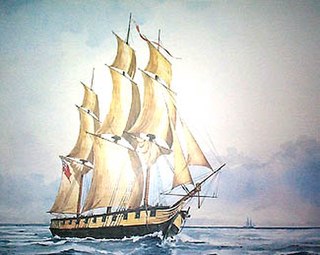
HMS Detroit was a 20-gun sloop of the Royal Navy, launched in July 1813 and serving on Lake Erie during the War of 1812. She was the most powerful British ship in the Lake Erie squadron until the Americans captured her during the Battle of Lake Erie on 10 September 1813. Detroit was commissioned into the United States Navy as its first USS Detroit. However, she was so damaged that the sloop took no further part in the war. Postwar, Detroit was sunk for preservation at Misery Bay off Presque Isle until 1833, when she was refloated and converted for commercial service. In 1841, Detroit was reduced to a hulk at Buffalo, New York, where she was purchased with the intent of sending her over Niagara Falls. The plan went awry and Detroit ran aground on a shoal before the falls and broke up.

The Welland Canal has gone through many incarnations in its history. Today, five distinct canal-construction efforts are recognized. The retronym First Welland Canal is applied to the original canal, constructed from 1824 to 1829 and 1831 to 1833.
Lot Clark was an American lawyer and politician from New York.
HMS General Hunter was a 10-gun brig of the Upper Canada Provincial Marine then, in 1813, the Royal Navy for their squadron on Lake Erie. She was ordered and built as a schooner in 1806 to replace Hope, a Provincial Marine vessel that had run aground in 1805. General Hunter was launched in 1807, entering service that year. With the outbreak of the War of 1812, General Hunter was converted to a brig and rearmed. As part of the Lake Erie squadron, General Hunter was present at the Battle of Lake Erie where the United States Navy defeated the British and gained control of the lake. General Hunter was captured at the battle and taken into American service. With the ship's name shortened to Hunter, she was used as a transport for the rest of the war. Following the war, the ship was sold into mercantile service. In 1816, the ship ran aground in a storm on Lake Huron and wrecked. The ship's contents were salvaged, but the wreck was left to be buried under the sand. In 2004, the wreck became the site of archaeological excavations and artifacts were retrieved from the site and placed in museums.
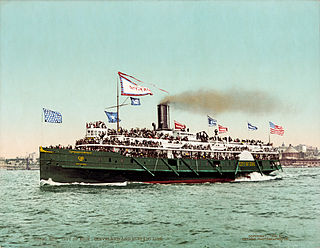
The SS City of Erie was a sidewheeler steamboat on Lake Erie. It was famous for being one of the fastest ships on the Great Lakes, at the time. It also won a race against a newer, rival ship.
Queen of the Lakes is the unofficial but widely recognized title given to the longest vessel active on the Great Lakes of the United States and Canada. A number of vessels, mostly lake freighters, have been known by the title.
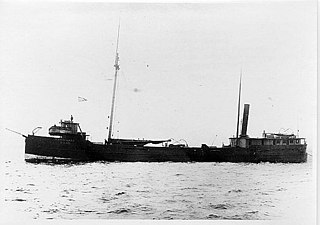
R. J. Hackett was a steamer built in 1869 in Cleveland, Ohio, by Peck & Masters. When the ship was first launched, both its wide cross-section and long midships hold were unconventional. The design's clear advantages in moving cargo through the inland lakes quickly resulted in many imitators.
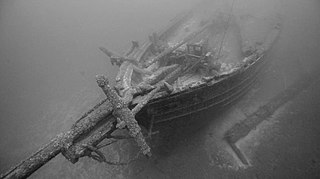
The F.T. Barney was a 19th-century American schooner that sank in 1868. Her wreck in Lake Huron near Rogers City, Michigan, was listed on the National Register of Historic Places in 1991.
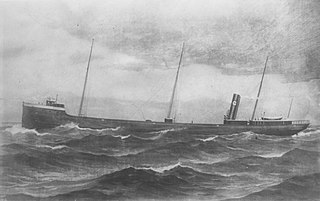
W.H. Gilcher was a steam lake freighter built in 1890–1891 by Cleveland Shipbuilding Company of Cleveland for Gilchrist, Gilcher & Schuck of Sandusky, with intention of transporting cargo between various ports located on Great Lakes. The ship was named after William H. Gilcher, one of the owners of the company. In October 1892 the freighter ran into a strong gale on Lake Michigan and foundered with the loss of eighteen men.

The SS John Sherman, originally the USRC Sherman or USRC John Sherman was built for the United States Revenue Cutter Service in 1865 before being disposed of by the United States Government in 1872. It was a United States sidewheeler ship initially used as a Revenue Cutter on the Great Lakes of North America before being used for ferry service across Lake Michigan between the states of Michigan and Wisconsin. In 1874 the ship was chartered by Flint and Pere Marquette Railroad to become the first ship used by the company transporting freight and passengers.

SS Onoko was an iron hulled Great Lakes freighter. She was launched in 1882 in Cleveland, Ohio as hull number #4, and sank on September 14, 1915 in Lake Superior near Knife River, Minnesota. Onoko is thought to be the prototype for every single steel hulled Great Lakes Bulk carrier that ever sailed. These vessels made possible the cheap transport of bulk cargoes such as iron ore, coal and limestone. Her wreckage still remains on the bottom of Lake Superior and was listed on the National Register of Historic Places in 1992.


SS Robert Wallace was a wooden-hulled American bulk freighter that served on the Great Lakes of North America from her construction in 1882 to her sinking in 1902 on Lake Superior near the town of Palmers, St. Louis County, Minnesota, United States. On November 17, 1902 shortly after leaving Superior, Wisconsin with a cargo of iron ore, Robert Wallace sprang a leak and sank. Her wreck was found in 2006, and on October 14, 2009, the wreck of Robert Wallace was listed in the National Register of Historic Places.

The George Spencer was a wooden lake freighter that sank on along with her schooner barge Amboy on Lake Superior, near Thomasville, Cook County, Minnesota in the Mataafa Storm of 1905. On April 14, 1994, the wrecks of the Spencer and the Amboy were listed on the National Register of Historic Places.

The Amboy was a wooden schooner barge that sank along with her towing steamer, the George Spencer on Lake Superior off the coast of Schroeder, Cook County, Minnesota in the United States. In 1994 the remains of the Amboy were added to the National Register of Historic Places.
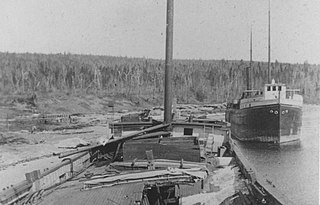
The AmboyandGeorge SpencerShipwreck Site is an archeological shipwreck site which consists of the wrecks of the wooden bulk freighter George Spencer and the wooden schooner-barge Amboy. Both vessels were wrecked during the Mataafa Storm of 1905. In 1994 the site was added to the National Register of Historic Places.














